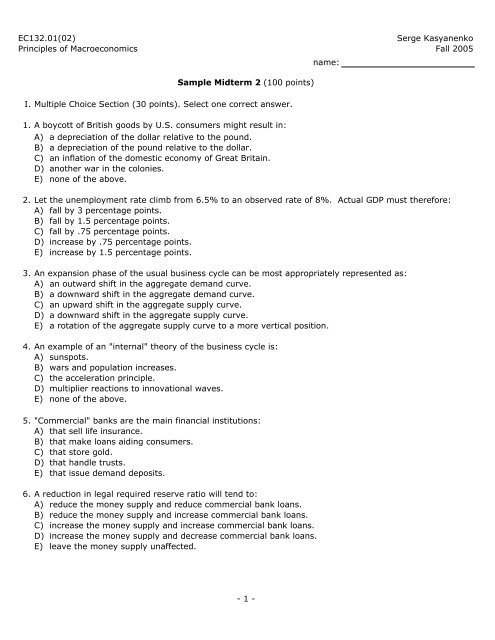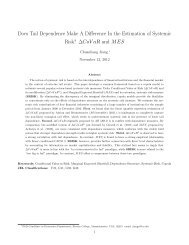I. Multiple Choice Section (30 points).
I. Multiple Choice Section (30 points).
I. Multiple Choice Section (30 points).
Create successful ePaper yourself
Turn your PDF publications into a flip-book with our unique Google optimized e-Paper software.
EC132.01(02)<br />
Serge Kasyanenko<br />
Principles of Macroeconomics Fall 2005<br />
Sample Midterm 2 (100 <strong>points</strong>)<br />
I. <strong>Multiple</strong> <strong>Choice</strong> <strong>Section</strong> (<strong>30</strong> <strong>points</strong>). Select one correct answer.<br />
1. A boycott of British goods by U.S. consumers might result in:<br />
A) a depreciation of the dollar relative to the pound.<br />
B) a depreciation of the pound relative to the dollar.<br />
C) an inflation of the domestic economy of Great Britain.<br />
D) another war in the colonies.<br />
E) none of the above.<br />
name:<br />
2. Let the unemployment rate climb from 6.5% to an observed rate of 8%. Actual GDP must therefore:<br />
A) fall by 3 percentage <strong>points</strong>.<br />
B) fall by 1.5 percentage <strong>points</strong>.<br />
C) fall by .75 percentage <strong>points</strong>.<br />
D) increase by .75 percentage <strong>points</strong>.<br />
E) increase by 1.5 percentage <strong>points</strong>.<br />
3. An expansion phase of the usual business cycle can be most appropriately represented as:<br />
A) an outward shift in the aggregate demand curve.<br />
B) a downward shift in the aggregate demand curve.<br />
C) an upward shift in the aggregate supply curve.<br />
D) a downward shift in the aggregate supply curve.<br />
E) a rotation of the aggregate supply curve to a more vertical position.<br />
4. An example of an "internal" theory of the business cycle is:<br />
A) sunspots.<br />
B) wars and population increases.<br />
C) the acceleration principle.<br />
D) multiplier reactions to innovational waves.<br />
E) none of the above.<br />
5. "Commercial" banks are the main financial institutions:<br />
A) that sell life insurance.<br />
÷ B) that make loans aiding consumers.<br />
C) that store gold.<br />
D) that handle trusts.<br />
E) that issue demand deposits.<br />
6. A reduction in legal required reserve ratio will tend to:<br />
A) reduce the money supply and reduce commercial bank loans.<br />
B) reduce the money supply and increase commercial bank loans.<br />
C) increase the money supply and increase commercial bank loans.<br />
÷ D) increase the money supply and decrease commercial bank loans.<br />
E) leave the money supply unaffected.<br />
- 1 -
7. If all commercial banks were forced to keep 100 percent reserves on checking and saving accounts:<br />
A) no financial institution would make loans.<br />
B) multiple money creation would not be possible.<br />
÷ C) people could not have the modern convenience of check writing.<br />
D) all of the above would be true.<br />
E) none of the above would be true.<br />
8. Demand deposits are included as a form of money because:<br />
A) the government or central bank authorizes their use.<br />
B) there is gold to back them.<br />
C) people believe there is gold to back them.<br />
D) people can buy goods with them.<br />
E) people are ordered to accept them.<br />
9. The money-supply multiplier assumes that:<br />
A) all new money is deposited in checking accounts.<br />
B) individuals do not retain cash balances.<br />
C) banks do not hold excess reserves.<br />
D) all of the above.<br />
÷ E) none of the above.<br />
10. The real rate of interest is the rate of interest:<br />
A) paid on a loan after all other bank fees have been deducted.<br />
B) paid on a loan inclusive of all other bank fees and charges.<br />
C) banks charge their largest and most credit-worthy customers.<br />
÷ D) banks pay on deposits over $100,000.<br />
E) found by subtracting the inflation rate from the nominal rate.<br />
11. A Fed open-market purchase:<br />
A) increases only banks' liabilities.<br />
B) increases only banks' assets.<br />
÷ C) increases banks' assets and reduces their liabilities.<br />
D) increases banks' assets and liabilities together.<br />
E) has no effect banks' balance sheets.<br />
12. The link from monetary policy to changes in real macroeconomic variables is one that:<br />
A) depends not at all on the interest rate.<br />
B) depends only upon the sensitivity of investment to changes in the interest rate.<br />
C) depends only upon the sensitivity of demand for money to changes in the interest rate.<br />
÷ D) depends upon the sensitivity of both investment and the demand for<br />
money to changes in the interest rate.<br />
E) is direct, and works automatically within the walls of American banks.<br />
13. Required reserve ratios:<br />
A) exist primarily to ensure that deposits are safe.<br />
B) exist to penalize banks that are members of the Federal Reserve System.<br />
C) exist primarily to help the Fed control the money supply.<br />
D) exist for all of the above reasons.<br />
E) exist for none of the above reasons.<br />
- 2 -
14. In the official statistics, a worker who is so discouraged that he has<br />
stopped looking for employment is counted as:<br />
A) unemployed.<br />
÷ B) underemployed.<br />
C) in the labor force but not employed.<br />
D) not in the labor force in exactly the same way as a woman who works<br />
÷ exclusively at keeping house.<br />
E) none of the above.<br />
15. A reduction in reserve requirements of member banks tends to counter a recession by:<br />
A) raising interest rates.<br />
B) reducing excess reserves.<br />
C) increasing excess reserves.<br />
÷ D) decreasing outstanding loans.<br />
E) decreasing aggregate demand.<br />
- 3 -
II. True/False <strong>Section</strong> (20 <strong>points</strong>)<br />
For each question provide a short explanation (no more than 1-2 sentences) of your<br />
answer. Use equations if necessary<br />
1. (True/False)<br />
An increase in the discount rate would be a signal of a<br />
tightening in the money supply.<br />
2. (True/False)<br />
Growth in the labor force is the only identified source of<br />
growth in potential GDP.<br />
3. (True/False)<br />
If the Federal Reserve buys bonds, and the sellers prefer to<br />
keep the proceeds in currency, then the potential increase in<br />
the total money supply will be smaller than if they keep the<br />
proceeds in banks.<br />
4. (True/False)<br />
If the reserve requirement were 100%, then the money<br />
multiplier would equal 0.<br />
- 4 -
III. Definitions (20 <strong>points</strong>)<br />
For every question, give a short definition of all three terms and explain the link between<br />
the first two terms and the third one, shown in bold.<br />
1. (i) Open Market Operations, (iii) Money Supply, (iii) Interest Rate:<br />
2. (i) Nominal Interest Rate, (ii) Inflation Rate, (iii) Real Interest Rate:<br />
- 5 -
IV. Graphs (15 <strong>points</strong>)<br />
Use a separate diagram to answer each question. Label all axes, indicate initial equilibrium<br />
and show the direction of a change. Label the final state of the economy. If necessary,<br />
provide a short description for each graph.<br />
1.<br />
Show the effect of the higher government<br />
expenditure on the current account of an<br />
open economy.<br />
2.<br />
Show the effect of the higher reserve<br />
requirement on the interest rate in the<br />
economy.<br />
3.<br />
Show the effect of the higher minimum<br />
wage on the number of unemployed<br />
workers in the economy.<br />
- 6 -
V. Essay (15 <strong>points</strong>)<br />
The Fed is concerned with rising unemployment in the economy and is trying to design<br />
measures to mitigate economic slowdown.<br />
a.<br />
Briefly describe what policies the Fed can implement to achieve this target.<br />
b. Choose one of the policies, you suggested in the previous question, and track its effect on<br />
the financial system, given that the initial state of the Fed and commercial banks is<br />
described as:<br />
(Use the same steps as in the problem set)<br />
Reserve Requirement 10%<br />
Federal Reserve Balance Sheet<br />
Balance Sheet of Commercial Banks<br />
Assets<br />
Liabilities<br />
Assets<br />
Liabilities<br />
Securities <strong>30</strong>0 Currency 250 Reserves 50 Dem. Dep. 500<br />
Reserves 50 Loans 450<br />
Total <strong>30</strong>0 Total <strong>30</strong>0 Total 500 Total 500<br />
Policy description:<br />
Instrument Chosen:<br />
Size of the Instrument:<br />
(i) Immediate Change<br />
Federal Reserve Balance Sheet<br />
Balance Sheet of Commercial Banks<br />
Assets Liabilities Assets Liabilities<br />
Securities Currency Reserves Dem. Dep.<br />
Reserves<br />
Loans<br />
Total Total Total Total<br />
(ii) Final Adjustment<br />
Federal Reserve Balance Sheet<br />
Balance Sheet of Commercial Banks<br />
Assets Liabilities Assets<br />
Liabilities<br />
Securities Currency Reserves Dem. Dep.<br />
Reserves<br />
Loans<br />
Total Total Total Total<br />
- 7 -
. Using graphs, show the effect of this policy on the interest rates, prices and output. If<br />
necessary, provide a short description of your graphs.<br />
- 8 -

















